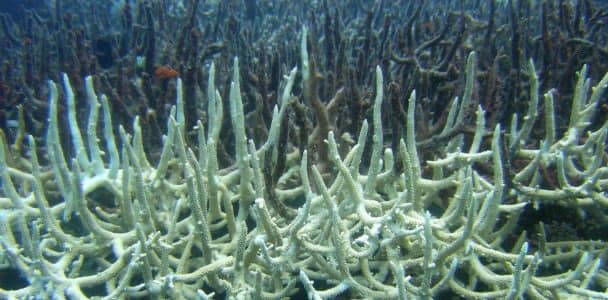With the approval of dredging as part of the Abbot Point port expansion, Australia has given the green light to an increase in coal exports.

While opposition to the plan has focused primarily on the effects of dumping dredge spoil near the Great Barrier Reef, climate change has been missing from the discussion.
Increasing coal exports will play a significant part in the decline of the Great Barrier Reef, and will prove to be a very uneconomical decision for Australia.
Going, going …
The Great Barrier Reef is a World Heritage listed marvel that spans 2000 kilometres of the Queensland coastline. It is rich in ecosystems and species, which attract business worth more than A$5 billion each year to Australia, employing more than 64,000 people.
If we were to manage the reef sustainably, it would be the ecosystem that keeps on giving through tourism and ecosystem services such as protecting the coast, and providing a sanctuary and nursery for marine life.
Despite efforts to date, however, the Great Barrier Reef is in deep trouble. The Australian Institute of Marine Sciences has rigorously recorded the decline of reef-building corals, which are essential to the reef’s existence.
These records show that the reef has lost about half of its coral cover since the early 1980s. The researchers found that tropical cyclones (48%), predation by the crown-of-thorns starfish (42%) and ocean warming (10%) were responsible for the decline.
Driving these changes are the modifications that humans have made, and are continuing to make, along the Queensland coastline. We have dramatically reduced water quality by deforesting river catchments, expanding coastal agriculture, and building major ports.
Climate change and ocean acidification have been steadily ramping up, with predictions that ocean warming will decimate reef-building corals by the middle of this century.
Despite some claims, there is next to no evidence that evolution (genetic adaptation) can keep pace with this rate of change, the highest for tens of millions of years.
This leaves a world-class environmental asset at serious risk from the activities of industries that line its coastal borders. As we prepare to build bigger and bigger ports, and export more and more fossil fuels, we are driving in a direction that will almost certainly eliminate the Great Barrier Reef over the next few decades.
Given the billions of dollars in tourism and fisheries revenue that the reef generates each year, countering this trend makes good business as well as sound environmental sense.
Burning through our carbon budget
One perspective is that we have some room to export coal and gas while we seek other solutions. Surely, we can export some of the fossil fuels that are available in the Queensland hinterland and then change tack?
Unfortunately, this perspective is at odds with the numbers.
The first number is that globally we only have 565 billion tonnes of carbon dioxide left to emit before we send atmospheric concentrations beyond 450 ppm CO2, which will probably drive global temperatures at least 2C above the pre-industrial average.
This limit is broadly accepted by the international scientific community as the level beyond which the impacts of climate change become largely unmanageable and dangerous (the so-called “climate guardrail”).
At a global annual emissions rate of 32 billion tonnes, this means we have only 15 years before global emissions need to fall to zero. That’s not a lot of time to sneak out those fossil fuels to the global market.
The second number is that proven reserves owned by private and public companies, and governments, equate to 2,795 billion tonnes of CO2 if burned.
The coal from Queensland’s Galilee Basin alone would release enough CO2 to use up 6% of the 565 billion tonne guardrail.
As Malte Meinshausen from the Potsdam Institute for Climate Impact Research has previously pointed out, this means that roughly 80% of these recognised fossil fuel reserves cannot be burned unless technologies such as carbon capture and storage can be made to work at a much greater scale.
However, even under the most optimistic circumstances (with financing yet to be secured), the total CO2 that is likely to be stored globally amounts to about 125 billion tonnes – a small fraction of the total fossil fuels in train to be burned.
Shooting ourselves in the foot
In a crowded export market, this doesn’t bode well for companies and governments investing in the mines and infrastructure for shipping fossil fuels to the rest of the world. With the Australian government’s preoccupation with rapid coastal development, dredging, and fossil-fuel exports, the impacts will accumulate.
Not only are we contributing to a declining water quality along the Queensland coastline, but we are rapidly escalating our capacity to supply fossil fuels to the rest of the world. At best this is a strange form of self-harm. But given that the writing is on the wall for fossil fuels, are we risking our economy and prosperity as well? Stranded assets and carbon bubbles come to mind.
To anyone outside Australia, it might look as if we’ve got it in for the Great Barrier Reef. With the rush to dredge and build along the Queensland coastline, we are choking an ecosystem that has provided enormous support to industry and the community.
At the same time, we appear to be shooting ourselves in the foot by exporting fossil fuels, which will ultimately drive the climate into a state where the Great Barrier Reef will be but just a memory.
Surely, we should be using the same infrastructure investments to build strong tourist and manufacturing sectors along with the renewable energy infrastructure that will ensure that the ecosystem that keeps giving to the Australian economy will do so in perpetuity.
But we are not. One has to ask, then, where is the logic or economics in all of this?
Written by Ove Hoegh-Guldberg. Originally published in The Conversation.


